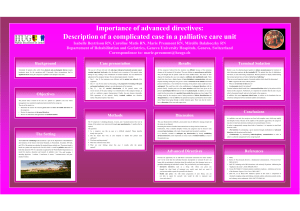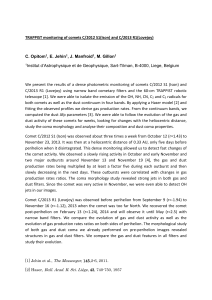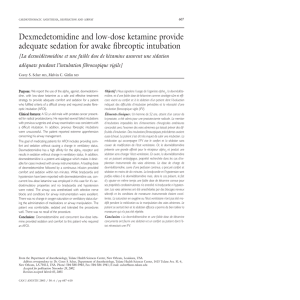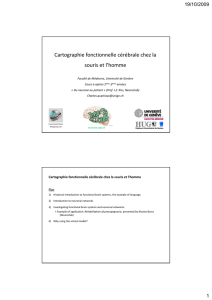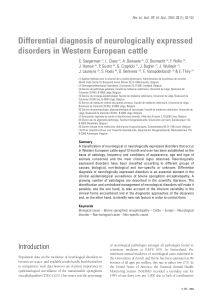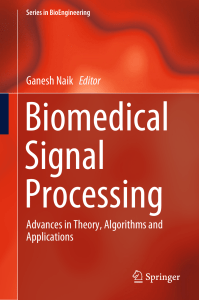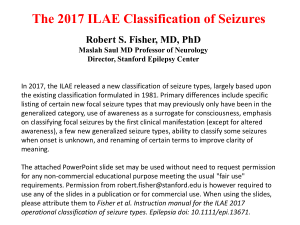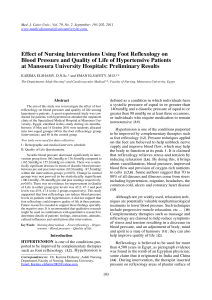EXAMEN NEUROLOGIQUE DU PATIENT DE REANIMATION
publicité
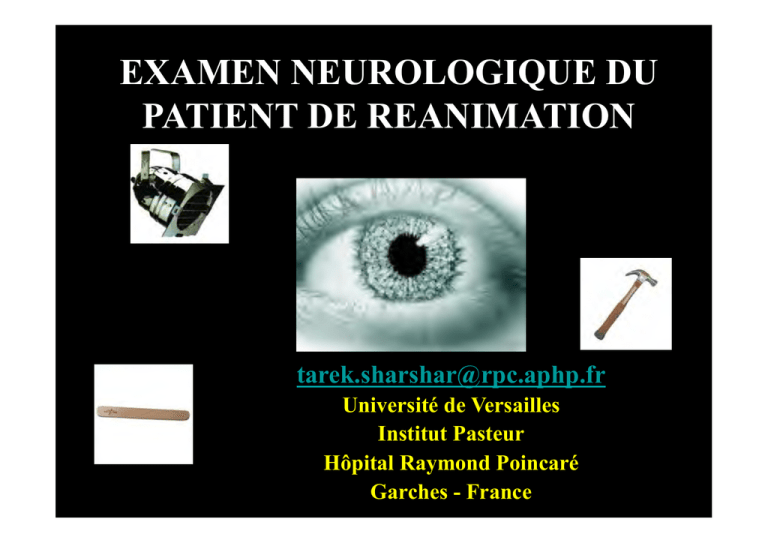
EXAMEN NEUROLOGIQUE DU PATIENT DE REANIMATION [email protected] Université de Versailles Institut Pasteur Hôpital Raymond Poincaré Garches - France NEUROLOGICAL EXAMINATION Admission 1. Neurological disease as cause for admission 2. Preexisting neurological disease (interpretation of subsequent neurological complication) Critical illness 1. Detection of ICU-neurological complication 2. Prevention of ICU-neurological complication Recovery of critical illness 1. Diagnosis of ICU-neurological complication 2. Treatment of ICU-neurological complication Discharge 1. Follow-up of ICU-neurological complication LE SYSTÈME NERVEUX CENTRAL 1. COMA 2. SYNDROME CONFUSIONNEL 3. EPILEPSIE 4. EXAMEN NEUROLOGIQUE DU PATIENT SEDATE 5. COMPORTEMENT DE MALADIE 6. TROUBLES COGNITIFS 7. SYNDROMES MEDULLAIRES LE COMA • Present in 25-60% of ICU patients • Leading predictor of – Death – Length of mechanical ventilation – LOS • Coma assessment (GCS) is an integral component in the most widely used intensive care scoring systems – APACHE – SAPS – SOFA Stevens - Crit Care Med - 2006 DEFINITION ALTERATION OF WAKEFULNESS (absence of arousal) - Lack of eyes opening - Absence sleep-wake cycles ALTERATION OF AWARENESS - Of self - Of environment • Comatose patients are not sleeping • Comatose patients do not speak, do not move spontaneously and do not follow commands. • When provoked by a noxious stimulus, their eyes remain closed, vocalization is limited or absent, and motor activity is absent or abnormal and reflexive rather than purposeful or defensive . NON-ORGANIC Presence of avoidance - Blinking to threat - Do not let hand fall on his face If any doubt, do an EEG COMATOSE PATIENT SCALE Eyes response FOCAL SIGNS Comparison between right and left body 1. Motor responses to order or painful stimulation 2. Limbs tone 3. Tendon reflexes 4. Plantar reflex MYOCLONUS 1. Limbs 2. Lids Motor response Verbal response BRAINSTEM RESPONSES 1. Eyes spontaneous movement 2. Eyes position 3. Oculocephalogyre response 4. Oculovestibular response 5. Pupillar size 6. Pupillar light reflex 7. Corneal reflex 8. Grimace 9. Cough reflex 10. Oculocardiac response 11. Respiratory pattern MOTOR RESPONSE External rotation of lower limb + babinski decortication « décérebration » COMATOSE PATIENT EYES POSITION Bilateral hemispheric Hemispheric / pons Thalamus / mesenceph Skew deviation (Cajal nuclei) Wijdicks E.F.M. Plum and Posner COMATOSE PATIENT A: roving B: periodic alternating gaze (bi H., cereb.) C: ping pong (bi H., cereb.) D: convergence nystagmus (mesenceph.) E: bobbing (pons) F: dipping (bi H.) Wijdicks E.F.M. PUPILS Adapted from Plum and Posner's Diagnosis of Stupor and Coma SIXTH NERVE PALSY No localisation value Intracranial hypertension THIRD NERVE PALSY THIRD NERVE PALSY Aneurysm I.C. or A.S. Cavernous sinus thrombosis Uncal herniation HERNIATION CLAUDE BERNARD HORNER Medulla (Wallenberg) Spine Dissection Catheter Cancer Sympathetic nervous system -­‐ Cheyne-­‐Stokes Respiratory centers are func0oning (autre cause = Low cardiac output) -­‐ Hyperven=la=on Acidosis, Sepsis +++ RESPIRATORY PATTERN -­‐ Apnea -­‐ Gasps et Apnée Respiratory centers aere altered Plum and Posner's Diagnosis of Stupor and Coma OTHER RESPIRATORY SIGNS • Yawning – Low value for localisation (Bulbar, can be seen in Locked-in or during temporal seizure) • Hick-up: – irritation of X/ medullar tegmentum bulbaire – corticosteroids… • Vomiting: – Intracranial hypertension, lesion of medulla or pons… VITAL SIGNS • HYPERTENSION – – – – Adrenergic storm +++ Intracranial hypertension toxic (amphétamin, cocaine) hypertensive encephalopathy (PRES) • HYPOTENSION – shock, (can be the cause of the coma +++) – Neurogenic myocardiac dysfunction (ou « Tako-Tsubo ») • RESPIRATORY DISTRESS – Can be cause of the coma +++ – Medulla syndrome – Neurogenic pulmonary edema • HYPERTHERMIA – Infection,: méningitis/encéphalitis/abscesses, paludism +++ – Heat stroke FOUR & GLASGOW COMA SCALES Patients with the lowest GCS score could be further distinguished using the FOUR score. Wijdicks et al – Ann Neurol - 2005 She is fine, she is sleeping… • 27/11/10 : 74 years old and aplasic patient • 1-2/12/11 : Pneumoniae and shock (Pseudomonas Aeruginosa et Stenotrophomonas Maltophilia) • 5/12/11 : Non sedated. The patient is sleeping… She is fine, she is sleeping… Delirium / Confusion DSM IV : Diagnostic Statistical Manual (of American Psychiatric Association) A. Trouble de conscience : diminution de la réactivité à l’environnement, difficultés attentionnelles, à se concentrer B. Atteinte d’une ou plusieurs fonctions cognitives : – – – – Trouble du langage Troubles de mémoire Désorientation temporelle et spatiale Troubles du jugement et du raisonnement C. Apparition brutale ou rapidement progressive (mn, heures ou jours), fluctuation des symptômes au cours du temps D. Le trouble est lié à un ou plusieurs des éléments suivants : – Pathologie médicale – Prise médicamenteuse / intoxication – Sevrage Romain Sonneville INCIDENCE Auteur, année Population Réa, n Critère (échelle) Fréq. Dubois, ICM 2001 Med-chir, n=216 Delirium (ICDSC) 19% Ely, CCM 2001 Med, n=48 Delirium (CAMICU) 60% Ely, Crit care 2003 Med non ventilés, n=261 Delirium (CAMICU) 48% Woods, ICM 2004 Med, n=143 Agitation (MAAS) 16% Ely, JAMA 2004 Med et USIC, n=224 Delirium (CAMICU) 82% Jaber, Chest 2005 Med-chir, n=211 Agitation (Ramsay) 52% Ely, ICM 2007 Chir-Trauma, n=100 Delirium (CAMICU) 70% Ely, JAMA 2007 Med-chir, n=106 Delirium (CAMICU) 80% Delirium (ICDSC) 32% Ouimet, ICM 2007 Med-chir, n=820 DISTRIBUTION Ely et al – JAMA - 2004 DELIRIUM TYPES Hyperactive delirium: agitation, restlessness, emotional lability Hypoactive delirium: withdrawal, flat affect, lethargy and decreased responsiveness DELIRIUM SCALES Sedation/Agitation : - RAMSAY - Richmond Agitation Sedation Scale (RASS) - Adaptation to the Intensive Care Unit Environment (ATICE) Delirium : - Confusion Assessment Method for the ICU (CAM-ICU) - Intensive Care Delirium Screening Check-list (ICDSC) MUST BE COMPLETD BY 1. A FULL NEUROLOGICAL EXAMINATION (focal sign, neck stiffness…) 2. EEG Intensive Care Delirium Screening Checklist (ICDSC) 8 items, côtés 0 ou 1 Réalisée une fois par 8 heures Si total > ou = 4 : DELIRIUM 1. 2. 3. 4. 5. 6. 7. 8. Conscience altérée (Si A ou B, ne pas poursuivre évaluation) A. B. C. D. E. Pas de réponse à une stimulation : ne pas coter Réponse à une stimulation intense et répétée (voix, douleur) : idem Réponse à une stimulation modérée : 1 Patient normalement éveillé : 0 Réponse exagérée à la stimulation : 1 Inattention (0 ou1) Désorientation (0 ou 1) Hallucinations (0 ou 1) Agitation ou ralentissement psycho-moteur (0 ou 1) Discours ou humeur inappropriés (0 ou 1) Troubles du cycle veille-sommeil (0 ou 1) Fluctuations des symptômes (0 ou 1) Bergeron ICM, 2001 FACTEURS DE RISQUE/CAUSES HOST FACTORS CRITICAL ILLNESS FACTORS IATROGENIC FACTORS Age (older) Acidosis Immobilization Alcoholism Anemia Medications (opioids, bzd) APOE4 Fever/infection/sepsis Corticosteroid Hypotension AB neurotoxicity Depression Metabolic disturbances (for example, sodium, calcium, BUN, bilirubin) Sleep disturbances Hypertension Withdrawal syndrome Smoking Respiratory disease/ congestive heart failure Vision/hearing impairment High severity of illness Cognitive impairment Dehydration, dyspnea MULTIFACTORIAL CASE REPORT 2 A 55 years old man was hospitalised for a septic shock. Blood culture were positive to Staphylococcus aureus and CSF analysis showed an aseptic meningitis. At admission, neurological examination was normal as well as MRI of the brain and spine. Transoesophageal cardiac ultrasound only showed a thrombus in the left atria. He also underwent surgery for a septic arthritis of the right knee. A right jugular catheter could not be put. A goitre was also noticed. Vasopressor and mechanical ventilation were discontinued the 3rd and 5th days from admission. The patient was treated with methicillin and heparin. Day 8, the patient developed agitation and delirium. Neurological examination showed a weakness of the right arm and slight right central facial palsy as well a ptosis and miosis of the right eye. The right arm was also oedematous. The brain CT scan and CSF analysis were normal. EEG showed a slow cortical activity. Biochemical screening showed a moderate renal insufficiency. Blood culture were negative. Case reprot 2 1. Left pre-rolandic lesion 2. Thrombosis of right jugular vein 3. Orbenin overdose CAS CLINIQUE Mme X…, âgée de 53 ans, traitée par CS et I- pour un LED, est hospitalisée pour une insuffisance rénale aiguë en rapport avec une Mat traité par EP compliqué d’un hématome de la cuisse. Survenue d’un état d’agitation et délirant: « on me vole mon enfant, les médecins me vole mon enfant… » CRISE D’EPILEPSIE Population Monitoring Seizure CS NCS Wijdicks 1996 Liver transplant (n=630) Clinical 28 (4%) 28 (4%) - Navarro 2010 Heart transplant (n=166) Clinical 8 (4.8%) 8 (4.8%) - Oddo 2009 Critically ill (n=201) cEEG 45 (22%) 10 (48%) 35 (78%) cEEG 110 (19%) Claassen Altered consciousness 2004 (n=570) 9 (1%) 101 (18%) * CS: convulsive seizure ** NCS: non convulsive seizure ETIOLOGY Critical illness Neurological pathology Varelas and Mirski – J Neurosurg Anesth - 2001 ETIOLOGY Medical and surgical ICUs Clinically symptomatic Causes of new onset seizures in critical illness Drug withdrawal (Morphine, midazolam…) Metabolic abnormalities (hypoNa, HypoCa2+…) Drug toxicity (antibiotics, antiarythmics…) Stroke Unknown N = 55 18 (32%) 10 (18%) 8 (14%) 5 (9%) 6 (11%) Wijdicks and Sharbrough – Neurology - 1993 WHEN DOING AN EEG? • • • • • Clinical suspicion of seizure 1. 2. 3. 4. 5. Abnormal limbs movement Abnormal ocular movement Facial myoclonia Unexplained coma Unexplained delirium Diagnosis of coma (if doubt) Diagnosis of brain death Diagnosis of metabolic encephalopathy Monitoring (TBI, SHA, Hypothermia….) SEIZURE • Seizure versus SE (emergency) • CSE (emergency) versus NCSE • Subtle SE (emergency) versus other NCSE Melerkorp and Holtkamp – Lancet Neurology - 2007 DYSFONCTION NEUROLOGIQUE AIGUË CHEZ LE PATIENT SEDATE ERREUR(S)? A 52 years old and alcoholic man was hospitalised in ICU for an hypoxemic community-acquired pneumonia, with blood cultures positive to S. pneumoniae. At admission, neurological examination was normal and there was no neck stiffness. One day later, he required mechanical ventilation and developed agitation, which was treated with Haloperidol. Because he became more and more agitated, he was heavily sedated. Agitation was ascribed to alcohol withdrawal. A week later, while the patient was sedated, bilateral larged fixed pupils were observed. CT scan showed diffuse brain oedema and lumbar puncture meningitis. ERREURS 1. Absence d’interprétation clinique de l’agitation. 2. Absence de monitoring de la sédation. 3. Considérer que l’examen neurologique chez un patient sédaté est ininterprétable . 4. Rapporter l’ ’agitation uniquement à un sevrage éthylique? 5. Ne pas avoir fait de PL lorsque le patient a été sédaté. SEVRAGE ETHYLIQUE By definition, the patient must have two or more of the following after cessation or reduction of alcohol use that has been heavy or prolonged: 1. autonomic hyperactivity (sweating, tachycardia); 2. increased hand tremor; 3. insomnia; 4. nausea or vomiting; 5. transient visual, tactile, or auditory hallucinations or illusions; 6. psychomotor agitation; anxiety and tonic-clonic seizures. Treatment: BZD Clinical Institute Withdrawal Assessment Scale for Alcohol, DTS is characterised by a fluctuating disturbance of consciousness and change in cognition occurring over a short period of time. It is accompanied by a further exacerbation of autonomic symptoms (sweating, nausea, palpitations and tremor) and an exacerbation of psychological symptoms including anxiety. EFFECTS OF SEDATION • Severe septic or critically ill patients often require sedation • Sedation is a risk factor for delirium • How to detect acute brain dysfunction in sedated critically ill patients? DESIGN Non brain injured critical ill patients [12-24h] 1st N.E Every day N.E Discontinuation of sedation Within 3 days Coma/Delirium Reproducibility of neurological examination was satisfactory Sharshar et al – Crit Care Med – 2011 NEUROLOGICAL EXAMINATION 12-24H OF SEDATION Fitting set Validation set Number of patients 72 72 Midazolam (mg/kg) 0.9 (0.6 to 1.8) 1.3 (0.8 to 2.0) Subfentanyl (µg/kg) 2.0. (0.8 to 4.0) 2.0 (0.7 to 4.6) sedation to inclusion (hours) 12 (12-24) 12 (12-24) ATICE (from 0 to 20) 9 (9 to 10) 9 (9 to 10) RASS Not tested -4 (-4 to -2) Blinking to strong light (%) 31 (43) 28 (39) Absent eye movement (%) 66 (93) 67 (93) Myosis (%) 45 (63) 38 (54) Pupillary light response (%) 51 (71) 58 (82) Corneal reflex (%) 65 (90) 66 (92) Oculocephalic response (%) 32 (47) 33 (46) Cough response (%) 36 (51) 60 (83) Grimacing (%) 41 (57) 48 (69) 28-DAYS MORTALITY Multiple logistic model RESPONSES ASSESSED BETWEEN THE 12Th AND 24th H OF SEDATION Fitting set Validation set OR (95%CI) P OR (95%CI) P SAPS-II at inclusion 1.06 (1.02 to 1.09) 0.003 1.03 (1.00 to 1.07) 0.051 Absent cough response 7.80 (2.00 to 30.4) 0.003 5.44 (1.35 to 22.0) 0.017 C-index (SE) 0.836 (0.055) 0.743 (0.067) Sharshar et al – Crit Care Med - 2011 ALTERED MENTAL STATUS (after discontinuation of sedation) Multiple logistic model RESPONSES ASSESSED BETWEEN THE 12Th AND 24th hours of sedation Criteria SAPS-II at inclusion Fitting set Validation set Confusion or coma Delirium or coma OR (95%CI) P OR (95%CI) P 1.04 (1.00 to 1.07) 0.058 1.03 (0.99 to 1.08) 0.10 5.64 (1.63 to 19.5) 0.006 Absent oculocephalic response 4.49 (1.34 to 15.1) 0.015 Sharshar et al – Crit Care Med - 2011 NEUROLOGICAL EXAMINATION 1. Feasible, reproducible and interpretable 2. Enables to detect focal neurological sign 3. Enables to estimate critical illness severity (cough reflex) 4. Enables to identify patient at risk to develop delirium after sedation discontinuation (Oculocephalogyre response) – Titration of sedation? Sharshar et al – Crit Care Med - 2011 NEUROLOGICAL PROFILES n (%) GCS Eyes response GCS Motor response Myosis Pupillar light reflex Corneal reflex Oculocephalogyre reflex Grimace Cough reflex Class1 68 (35%) 1 (2 to 3) 4 (4 to 6) 30 (44) 64 (94) 68 (100) 55 (81) 63 (93) 65 (96) Class 2 81(41%) 1 (1 to 1) 1 (1 to 1) 46 (57) 70 (86) 77 (95) 45 (56) 61 (75) 68 (84) Class 3 48 (24%) 1 (1 to 1) 1 (1 to 1) 39 (81) 28 (58) 31 (65) 2 (4) 0 (0) 24 (50) p < 0.0001 < 0.0001 0.026 < 0.0001 < 0.0001 < 0.0001 < 0.0001 < 0.0001 Rohaut et al - Submitted NEUROLOGICAL PROFILES Median (IQR); n (%) Midazolam infusion rate Midazolam cumulative dose Sufentanyl infusion rate Sufentanyl cumulative dose Age Sexe (%) SAPS-II RASS Sepsis (%) Coma (%) Delirium (%) Coma & Delirium (%) ICU mortality (%) Class 1 Class 2 Class 3 p 84 (48) 4.9 (3.1) 1.7 (1.6) 10.1 (7.6) 3.6 (3.1) 61 (51 to 78) 32 (47) 47 (33 to 60) -2 (-4 to -2) 48 (71) 7 (11) 25 (41) 29 (47) 15 (22) 74 (33) 6.1 (4.0) 1.6 (1.7) 13.8 (11.0) 3.6 (4.3) 68 (55 to 80) 30 (37) 56 (40 to 75) -5 (-5 to -4) 61 (77) 13 (19) 35 (51) 43 (62) 23 (30) 36 (19) 6.0 (4.1) 1.5 (1.3) 13.1 (10.6) 3.5 (3.3) 74 (63 to 82) 18 (38) 58 (47 to 72) -5 (-5 to -5) 37 (79) 11 (28) 19 (51) 27 (71) 30 (62) 0.17 0.83 0.073 0.71 0.009 0.42 0.006 < 0.0001 0.54 0.08 0.45 0.041 < 0.0001 Rohaut et al - Submitted CASE REPORT Abolition of the left patellar reflex in 72 years old man who needed to be sedated for a very severe ARDS LONG-TERM COGNITIVE DECLINE MID-TERM COGNITIVE DECLINE 77 Medical ICU patients Memory Attention Concentration Hippocampus Frontal cortex Girard et al – Crit Care Med - 2010 Pandharipande et al – NEJM - 2013 COMPORTEMENT DE MALADIE REPONSE A L’AGRESSION ENCEPHALOPATHIE CONCEPT OF SICKNESS BEHAVIOR • Sickness behavior is a major, highly preserved and adaptive component of response to stress. • The sickness behavior includes stereotypical changes: anxiety, immobility, somnolence, starving, autonomic and neuroendocrine changes etc… • It involves the amygdala and hippocampus and is mediating by specific structures: circumventricular organs and vagal nerve . Dantzer et al – Nat Neurosci Rev-2008 PHYSIOLOGICAL BRAIN SIGNALLING Sickness behavior Adapted autonomic and neuroendocine response Vagal nerve Circumventricular organs (no BBB) + Delirium Dantzer et al – Nat Rev Sci - 2008 ANXIETY & FEAR (patients with GBS) N (%) 100 80 No MV MV 60 40 20 0 Dyspnea Pain Weakness Uncertainty Sharshar et al – BMJopen access-2012 PANICU PROJECT: TO ASSESS THE PROGNOSIS VALUE OF ANXIETY AT ADMISSION IN ICU Sickness behavior Neuroendcrine system Hippocampus Limbic system Psychologic disorders (Anxiety, depression, PTSD) Hippocampus Cognitive impairment (Memory and executive functions Brainstem Death Delirium Frontal cortex Coma Sedation + Acute brain dysfunction Brain structures Outcomes Sedation necessary Non sedated Sedated Brainstem reflexes Discontinuation of sedation EXAMINATION Monitoring Normal LUMBAR PUNCTURE IF ANY DOUBT Focal sign Brain imaging Myoclonus EEG - Biochemistry - Drugs Coma Delirium Agitation Brain imaging Antagonist? EEG - Biochemistry - Drugs Brain imaging Biochemistry - Drugs EEG UNCONTROLLED SEPSIS? Brain imaging DYSFONCTIONS CEREBRALES AIGUËS Medical history (Alcohol, Epilepsia…) Glycemia Circonstances (CO…) Fever Neck stiffness Focal sign Seizure Trauma Imaging, Imaging Imaging ± AB ± CSF ± AB ± CSF ± CSF EEG, Imaging Imaging ± CSF EEG SI DOUTE OU ABSENCE DE CAUSE / BILAN STANDARD SPINAL CORD SYNDROMES Complete transection Posterior spinal artery ALS Anterior spinal artery Brown Séquard Poliomyelitis Syringomyelic Subacute combined degeneration LE SYSTÈME NERVEUX PERIPHERIQUE PERIPHERAL NERVOUS SYSTEM Neurono neuropathy Neuropathy Myasthenic syndrome Myopathy Symmetry Bilateral ± symmetrical Variable MM: asymmetrical PN: symmetrical PRN: symmetrical Bilateral and symmetrical Bilateral and symmetrical Proximal vs distal Proximal or distal MM: distal PN: distal PRN: proximal Proximal ++ Proximal ++ Topography Limbs, Bulbar, respiratory MM: ≥ 1 nerve PN: limbs ± respiratory PRN: limbs, trunk, bulbar, facial, respiratory Variable Limbs, facial, bulbar, trunk or respiratory Ptosis (often unilateral) and diplopia Variable Limbs, facial, bulbar, trunk, respiratory MM: mononeuropathy multiplex; PN: polyneuropathy; polyradiculoneuropathy PERIPHERAL NERVOUS SYSTEM NeuronoNeuropathy Neuropathy Myasthenic syndrome Myopathy flaccidity flaccidity flaccidity flaccidity Lost or pyramidal signs (ALS) Lost or decreased Preserved Preserved Preserved Preserved Preserved Absent Atrophy Pronounced Pronounced No Variable Other motor signs Fasiculation - Fatigability Fluctuation Myalgia Myotonia Tone Tendon reflexes Idio-muscular response Other neurological signs Cramps No sensory ± sensory loss loss (except L. ± dysautonomia Eaton) No sensory loss MRC SUM SCORE Normal 60 Paresis 48 Severe 36 0 Kleyweg et al. - Muscle Nerve - 1991 SEMIOLOGY NM score • Weakness – Bilateral et symmetric – Four limbs – Essentially proximal – Sparing the face • ± sensory deficit • ± Areflexia • ± Amyotrophic 5,0 4,5 4,0 3,5 3,0 2,5 ANKLE 2,0 KNEE 1,5 HIP 1,0 WRIST 0,5 ELBOW 0,0 SHOULDER RIGHT LEFT CSF: not helpful CK: normal, slightly or highly increased (Status asthmaticus) De Jonghe et al JAMA 2002 ICU-ACQUIRED PARESIS Frequent and severe complication associated with 1. 2. 3. 4. Increased mortality Prolonged weaning and reintubation Increased length of stay in ICU Disability ENTRAPMENT NEUROPATHY Peroneal nerve Hypoesthesia Radial nerve Hypoesthesia in green area University of Versailles Raymond Poincaré Service de Réanimation Pr Djillali Annane Institut Pasteur Fabrice Chrétien Human Histopathology and Animal Models MERCI MID-TERM COGNITIVE DECLINE 225 Post-operative patients Saczynski et al – NEMJ - 2012 Iwashyna et at – JAMA - 2010 Swallowing dysfunction? Shah et al- AJRCCM - 2013 ELECTROPHYSIOLOGY ± Motor and sensory NCS (nerve) Needle EMG (muscle) Repeated stimulation (NMJ) Supramaximal nerve stimulation (muscle strength and fatigue) + Direct muscle stimulation (excitability) Eikermann et al-ICM-2006 ; Dhand - Resp Care - 2006 USEFULNESS • • • • Diagnosis of CINM Distinguiching CIM from CIP Predicting ICU-acquired paresis Predicting recovery ANATOMY A. Diffuse hemispheric lesion B. Diencephalic lesion C. Mesencephalic and diencephalic lesion D. Mesencephalic and pons lesion E. Pons lesion Plum and Posner APPROACH 1. 2. 3. 4. Diagnosis Severity Causes Prognosis DISCREPANCY Septic shock with ARDS and severe liver and renal failure in a aplasic 82 years old man. 1. Coma plus abolition of all brainstem reflexes 2. After discontinutaion of sedation, recovery of cough and oculocephalic repsonses but not of corneal reflex and grimace. CASE REPORT A 65 years old man was hospitalised for an acute respiratory failure that required invasive mechanical ventilation and sedation. Respiratory failure was ascribed to amiodarone interstitial pneumonia, Facial which was given with anticoagulant a palsy month ago for an atrial fibrillation. He had also a severe arteritis and coronary disease. A week later, while the patient was ventilated and lightly sedated, neurological examination showed no response of the left arm to painful stimulation, a greater hypotonia of the left arm and leg but also a decreased contraction of the right face to painful stimulation and right ptosis with small pupil. Weakness CASE REPORT Three days after discontinuation of sedation, the patient developed agitation and delirium. General and neurological examination was not changed. EEG was normal. Agitation and delirium was ascribed to discontinuation of sedation. Three days later, patient complained of pain of the legs and ankles that turned to be due to bacterial and ischemic myositis. DELIRIUM WITHOUT (new) FOCAL NEUROLOGICAL SIGN IN A RECENTLY NON SEDATED PATIENT CASE REPORT Tendon reflex became brisk in 72 years old man heavily sedated and paralyzed for a very severe ARDS (Spinal cord MRI: normal) CASE REPORT Presence of corneopterygoidien reflex in 34 years old man who needed to be sedated for a very severe ARDS complicating a CO poisoning ROSTRAL-CAUDAL DETERIORATION Motor response Cortical Verbal response Blinking to threat Subcortical Localizing Withdrawal Dience -phalic Paratonic Appropriate Motionless Arms flexed Legs stiffen (decorticate) Brainstem functions Pupils Breath pattern Fronto-orbicular Frontopalpebrae Mimic Small pupils Small range of contraction Cheynestokes ROSTRAL-CAUDAL DETERIORATION Motor response Brainstem functions Pupils Midbrain Motionless Arms and legs extended (decerebrate) Light pupillar reflex OCR, OVR (vertical) Unilateral fixed large (3rd nerve) Midposition and fixed (Tegmentum) Bilateral fixed large (tectum) Pons Motionless and flaccid or lower limbs flexion Corneal reflex OCR, OVR (horizontal) Corneal pterygoid reflex pinpoint Medulla Motionless and flaccid or lower limbs flexion Cough reflex Oculo-cardiac reflex Breath pattern Eupneic or ataxic Ataxic HYPOTHESES Continuum? Reversibility? Continuum : process posteriorly spreading from the area postrema (deprived from BBB, neuro-inflammatory signaling) HYPOTHESES - Difference in SAPS-II - Neuro-inflammatory process starting at the level of the area postrema (posterio localisation, no BBB) - No difference in term of sedatives dose - effect of sedation reduction on profil C or D? - Animal studies Neuro-inflammation Neuro-degeneration - Difference in age - Aging? Animal studies? Sensitivity to sedation NEUROLOGICAL ASSESSMENT GLASGOW COMA SCALE Eyes response FOCAL SIGNS Comparison between right and leY body 1. Motor responses to order or painful s=mula=on 2. Limbs tone 3. Tendon reflexes 4. Plantar reflex Verbal response Motor response 1. 2. 3. 4. 5. 6. 7. 8. BRAINSTEM RESPONSES Eyes spontaneous movement Eyes posi=on Oculocephalogyre response Pupillar size Pupillar light reflex Corneal reflex Grimace Cough reflex OR death 95% CI Age 1.38 1.16-1.65 Shock 3.87 1.96-7.65 Coma 20.22 9.42-54.09 CPR 13.4 5.18-34.63 CONCEPT OF BRAINSTEM DYSFUNCTION Abolition of oculocephalic response RAAS dysfunction Neuronal apoptosis of LC Death Multifocal necrotizing leukoencephalopathy Abolition of cough reflex Impaired HR/BP variability Neuronal apoptosis Sharshar et al – CCM – 2002; Sharshar et al – Lancet – 2004; Pandharipande et al – CC -2011; Annane et al – AJRCCM – 1999; Tracey et al – Nature Review Neuroci Delirium Autonomic dysfunction Hemodynamic failure Maladaptative immune response DIFFERENTIAL DIAGNOSIS OF PARAPLEGIA Areflexic and flaccid paraplegia Think about injury of the spinal cord, conus medullaris syndrome or a cauda equina syndrome, especially if there is a sensory level, urinary retention or pelvic hypoesthesia Doubt: usefulness of MRI, electrophysiological testing DELIRIUM PREVALENCE MORTALITY PREDELERIC SCORE Van den Bogaard et al – BMJ - 2012 ELECTROENCEPHALOGRAM • • Standard EEG in 110 septic patients - Septic shock: 45 (41%); sedation: 46 (42%) EEG within the 72h from admission Characteristics n=110 Dominant frequency – n (%) alpha 21 (19) delta 36 (33) theta Amplitude – n (%) low-voltage Absence of reactivity – n (%) Electrographic seizure – n (%) Triphasic waves – n (%) PEDs – n (%) Synek’s classification ≥ 3 – n (%) Young’s classification > 1 – n (%) 53 (48) 71 (65) 27 (25) 17 (15) 7 (6) 21 (19) 34 (31) 41 (37)Azabou et al - Submitted MECHANISMS OF LONG-TERM COGNITIVE DECLINE IN SEPSIS DIAGNOSTICS DIFFERENTIELS Droite Rotation de la tête OCULOCEPHAOLOGYRE RESPONSE Gauche Mouvement des yeux Cible Muscle droit externe Faisceau longitudinal médial Muscle droit interne OPHTALMOPLEGIE INTERNUCLAIRE ANTERIEURE
